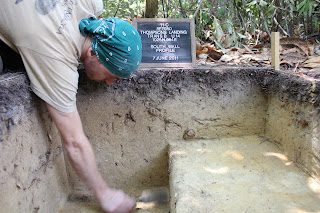One of the first artifacts recovered from a shovel test this summer was this small lithic point.
The item is a small stemmed biface with a reworked tip (point is oriented with tip facing down). The non-local material is Tallahatta Sandstone, which occurs in south central Alabama, just north of the Florida state line.
An exciting find from one unit is three mendable sherds that form a large part of an aboriginal pottery vessel. The vessel fragments are decorated with a check-pattern produced by stamping the exterior of the vessel with a carved paddle while the clay is still damp.
Additionally, a mend-hole is present on the lower left side of the picture. The prehistoric user of this vessel tried to extend its use by stringing some kind a fiber through a holes drilled on either side of a crack. As the fiber dried it might have pulled the crack closed enough for the vessel to be used again.
Will Wilson recoverd a Middle Woodland Period (100-500 AD) sherd in his test unit.
A close-up of the artifact shows a complicated-stamp typical of the Santa Rosa/Swift Creek culture.
This week we are half way finished with the combined field school. The first group of students completed their Phase I and II training. They did a great job and we would like to wish them “good luck” out on the water. Next week, we look forward to working with our second crew for the remainder of the summer!





























